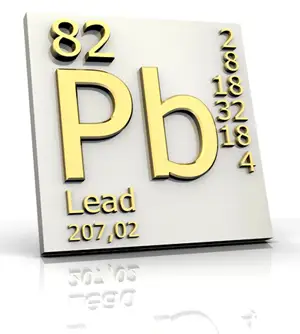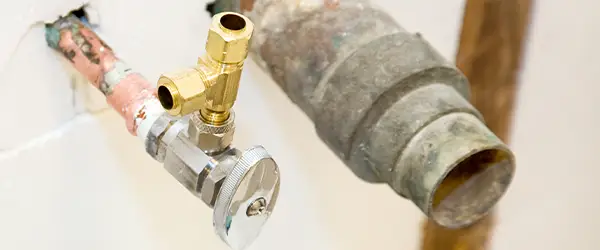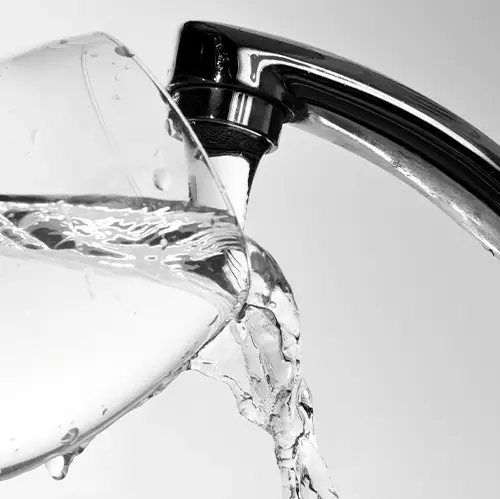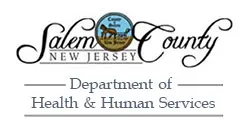Childhood Lead Exposure
Introduction
About Lead
What You Can Do
For Parents
For Pregnant Women
The Salem County Department of Health and Human Services provides nurse case management, environmental inspections and investigations, education and outreach materials, and free lead screenings.
Lead can damage nearly every system in the human body and has especially harmful effects for developing children.
In Salem County, lead exposure in children is most often related to lead paint in older homes. According to statistics provided by the New Jersey Department of Health, based on 2013 US census data, Salem County has the highest number of New Jersey housing units that were built before 1950, when lead paint was still in use. Approximately 29% of Salem County houses could have lead painted surfaces.
What do health department staff do to protect children from lead poisoning?
- Registered Nurses provide free lead screenings and education about potential sources of lead and lifestyle changes to prevent lead exposure. For children who are identified as having elevated blood lead levels, our nurses provide case management including medical and developmental follow-up, nutritional recommendations and referrals.
- Environmental Inspectors provide education, risk identification, interim control tips, and testing information for properties. They also inspect places where children with an elevated blood lead level live and spend time, to determine the source of lead exposure and work with owners and caregivers to create lead-safe and lead-free homes.
Staff members are available to speak to community groups, educators, and parent groups.
 Lead is a metal that occurs naturally in the environment. Although lead can be found in small amounts in the earth’s crust, most of it comes from human activities such as manufacturing and mining. In the past, lead was used in gasoline and household paint, and is still used in some metals, bullets, and batteries. We now know that lead has many hazardous health effects, and so lead has been banned or significantly reduced in these products.
Lead is a metal that occurs naturally in the environment. Although lead can be found in small amounts in the earth’s crust, most of it comes from human activities such as manufacturing and mining. In the past, lead was used in gasoline and household paint, and is still used in some metals, bullets, and batteries. We now know that lead has many hazardous health effects, and so lead has been banned or significantly reduced in these products.
There is no established safe level of lead in the human body. No exposure to lead can be regarded as free from potential harm. Lead exposure can affect nearly every system in the body. See the links above to read more on how lead can impact the health of children, pregnant women, and other adults.
Children can be exposed to lead in many ways, but most exposure happens when children put things into their mouths while playing. Lead was used in household paint until 1978, and any homes built before 1978 could have lead paint. Everyday use of windows and doors having lead paint creates invisible lead dust on flat surfaces such as floors. This dust or loose paint chips can be eaten or inhaled by crawling children. Lead can also be found in soil, water, and certain items that come from other countries. Many children with lead poisoning have no signs at first, which makes it hard to diagnose and treat. Therefore, having your child tested at ages one and two is so important.
Even very small amounts of lead can cause learning and behavior problems in children. Lead is most harmful to children under the age of six, because a child’s growing body and brain absorbs lead more easily. Lead can also be dangerous to a baby during pregnancy because lead can pass from the mother to the unborn baby.
Problems from lead poisoning can last the child’s entire life. Even low levels can cause a lower IQ , attention disorders, difficulty paying attention, delayed growth and development, impaired hearing, and more. It is important to find out about lead exposure before these effects become permanent. The only way to know is to test your child early.
GHHI – Lead Poisoning Awareness Video ⇒
Household Risk Factors
If you answer “yes” to any of these questions, have your child tested for lead:
- Does your child play with or have access to any areas where the following items are kept?
Antiques
Batteries
Candles
Coloring pigments
Drapery weights
Dyes
Electronics
Epoxy resins
Fishing sinkers
Fungicides
Gasoline
Gear oil
Lacquers
Markers
Mini-Blinds
Paints
Pesticides
Pipe sealants
Pool cue chalk
Putty
Shellacs
Solder
Tire weights
- Do you have a pet that could track in dirt or dust from the outside?
- Does your family use any food containers that are made from metal, pewter, homemade or imported ceramics, or leaded crystal?
- Does anyone in the home work in an industry with lead? (i.e., plumbing, construction, auto mechanic, painting, batteries, and farming.)
- Does your family use products from other countries such as herbal medicines, health remedies and cosmetics?
Examples include Azogue, Alkohl, Azarcon, Bali goli, Ghasard, Greta, and Pay-loo-ah.

Lead in Water
Here are some answers to some commonly-asked questions about lead in water.
How does lead get into my drinking water?
- Some parts of the plumbing system may contain lead such as sink fixtures, fittings, connectors, pipes and solder. In older homes the service connector pipe from the water main to the home may be made of lead. Drinking water that comes in contact with lead in a plumbing system of a home, high rise building, or city water distribution system may become contaminated.
- Although lead is present in nature, it is rarely found in groundwater or surface water that is used for drinking water.
How do I know if my tap water is contaminated with lead?
- The only way to know is to test your water. You cannot see, taste, or smell lead in water.
- Testing the water is especially important for apartment dwellers, because flushing may not be effective in high‐rise buildings.
Are faucet or pitcher water filter devices effective at removing lead?
- Some faucet mounted devices effectively remove both soluble and particulate lead, but most pour‐through water pitcher devices are not effective at removing particulate lead.
- You can go to the NSF International website to verify the effectiveness of the system you want to purchase

Home Risk Factors
If you answer “yes” to any of these questions, consider having your home tested for lead:
- Was your home built before 1978?
- Is there visible peeling or chipping paint on doors, windows, window wells and troughs, porch areas, siding, fences, garages, or play structures?
- Is/has your home undergone repairs or renovations?
- Is/was your property part of a farm? Fertilizers and gasoline used on farms often contained lead which may still be present in the soil.
- Is your home located near a lead-producing industry (battery plant, smelter, radiator repair shop, etc.)?
- Is your home located near buildings or structures that are being renovated, repainted, or demolished?

Water Risk Factors
If you answer “yes” to any of these questions, consider having your water tested for lead:
- Does your home use well water that has not previously been tested for lead?
- Do you use water from the tap as soon as it is turned on? Letting the water run will clear the pipes of water that is most likely to contain lead.
- Is tap water used to prepare infant formula, powdered milk, juices, or foods?
- Does your home have lead pipes or lead solder in the plumbing?

What can I do to decrease lead in my drinking water?
- If using tap water for drinking, baby formula, or cooking, use only COLD water. Never use hot water because it can absorb more lead from the plumbing system.
- Flush your water pipes before drinking or drawing water for cooking by running the water until it reaches the coldest temperature possible. This may take only a few seconds if water was recently heavily used (i.e. showering) or it could take a few minutes if the water sat in the pipes overnight (e.g. 5 minutes).
How do I test my water for lead?
- Contact your local health department to find a state-accredited laboratory to come out and have your water tested.
- Water test kits available at local hardware stores are NOT recommended by the EPA.
Where can I go for more information?
- US Environmental Protection Agency (EPA) Safe Drinking Water Hotline: 1-800-426-4791
- US EPA – Health Effects of Lead webpage
- Check the Consumer Product Safety Commission to see if any products you own may be recalled for lead contamination or other reasons:
These are some things you can do to help prevent lead poisoning:
- Wash hands well, and wash them often especially before eating.
- Keep your house clean.
- Clean floors often with a wet mop or towel to trap lead dust.
- Use a damp cloth for dusting and wiping of windowsills weekly.
- Eat healthy, well-balanced meals rich in iron, calcium, and vitamin c.
- Protect yourself if your job or hobbies expose you to lead, wash work clothes separately from all other household laundry.
- Remove lead contaminated clothes before entering your home.
- Leave shoes at the door.
- Wipe pets’ paws after walking outside.
Behaviors to Avoid
Avoiding these things will help to prevent lead exposure:
- Avoid peeling, chipping paint.
- Do not sand painted surfaces and floors.
- Avoid remodeling and lead paint removal.
- Do not use a heat gun to remove old paint.
- Never sweep or dust with a dry cloth or broom. Wet mops and cloths are best to trap the dust.
- Prevent your child from putting nonfood items into their mouth.
Exposure
Reducing Lead Hazards
If you believe your child is at risk for lead exposure, there are steps that you can take NOW to reduce the hazard.
- Understand where lead is found. Old paint, antiques, imported toys, etc. are potential sources.
- Make the healthy changes as recommended on this page.
- Reduce lead hazards with methods found in this brochure: Reducing Lead Hazards in the Home.
- Move child’s play areas or bedroom to a room that has no chipping or peeling paint.
- Place tape securely over chipping and peeling paint.
- Move furniture to block your child from other painted areas that are chipping and peeling.
- Clean frequently using the cleaning tips below.
Cleaning Tips for Reducing Lead Hazards
Before you begin cleaning:
- Review the cleaning methods found in the Cleaning Tips of Reducing Lead Hazards brochure.
- Remove all children, pregnant women, and pets from the room.
- Wear old clothes and gloves.
- Use only wet towels and mops to trap the lead dust. Dry towels and mops will spread lead dust.
- Use HEPA vacuums only to trap lead dust. Standard vacuums will spread lead dust into the air.
- Clean one room at a time.
Child Behavior Risk Factors
If you answer “yes” to any of these questions, your child could be at risk for lead exposure:
- Does your child live or visit a home built before 1978?
- Does your child crawl and spend time on the floor?
- Does your child put their fingers/hands in their mouth?
- Does bare soil or dust get tracked into the home by pets or shoes?
- Does your child put painted objects or surfaces into their mouth?
For example: toys, painted cribs, window sills, furniture edges, railings, door moldings, or broom handles. - Does your child put keys, key chains, jewelry, or other metal objects into their mouth?
- Does your child play in soil or put soil in their mouth?
- Does your child put printed material such as newspapers, magazines in their mouth?
Who should be tested for lead?
- Every child should be tested at ages one and two.
- Any child age 6 years and younger who has never been tested.
- Any child who may have been exposed to lead.
Where can I get testing done?
- Talk with your child’s doctor to discuss lead testing. Testing may be done in the doctor’s office by a finger stick or at a lab by a blood draw.
- The Salem County Department of Health & Human Services offers free lead screenings every first Thursday of the month at 110 Fifth Street, Salem, NJ 08079 from 1 p.m. – 3p.m.

Lead is dangerous for a developing baby, and it can be found in the blood and bones of pregnant women who have been exposed to lead hazards. Both you and your baby can be harmed by lead.
Once lead is in the body, it can cross the placental barrier and affect the unborn baby. Immediate effects can include premature delivery and low birth weight, as well as an increased risk of miscarriage or stillbirth.
If you are pregnant, or thinking of becoming pregnant, talk to your doctor to learn how to prevent lead poisoning.
What You Can Do
These are some things you can do to help prevent lead poisoning while pregnant.
- Eat healthy, well-balanced meals rich in iron, calcium, and vitamin C.
- Never put non-food items in your mouth (sometimes pregnant women may have an urge to eat things that are not food). If you have the urge to eat non-food items, discuss this with your doctor. Some examples: corn starch, crushed pottery, dirt.
- Keep regular prenatal and pediatric doctor visits.
- Avoid lead dust. If you suspect there is lead in the home, have someone else do the cleaning.
- Avoid any area where home painting, repairs or renovations are occurring.



